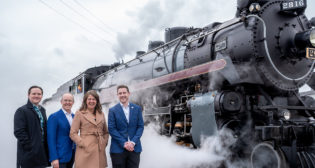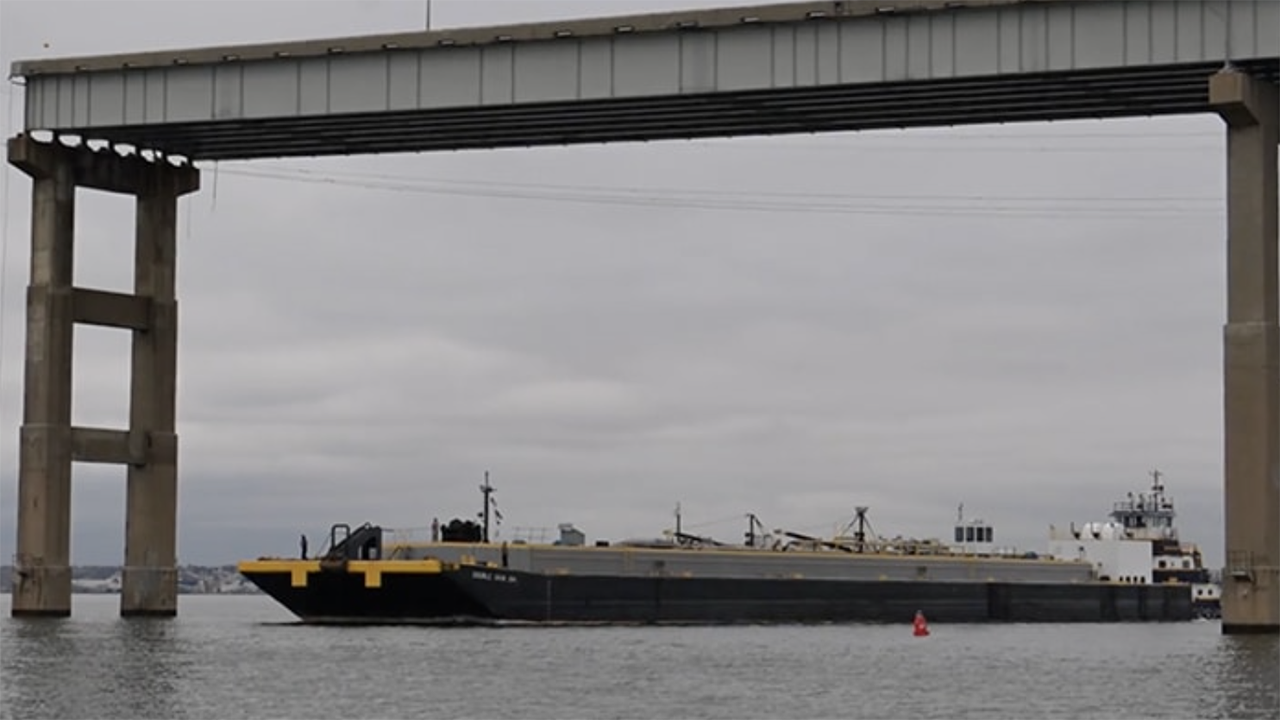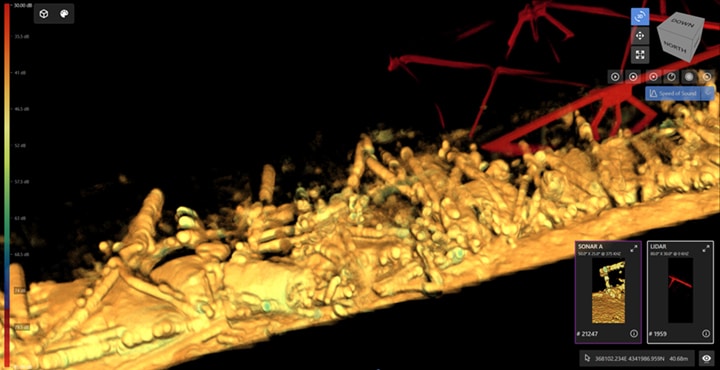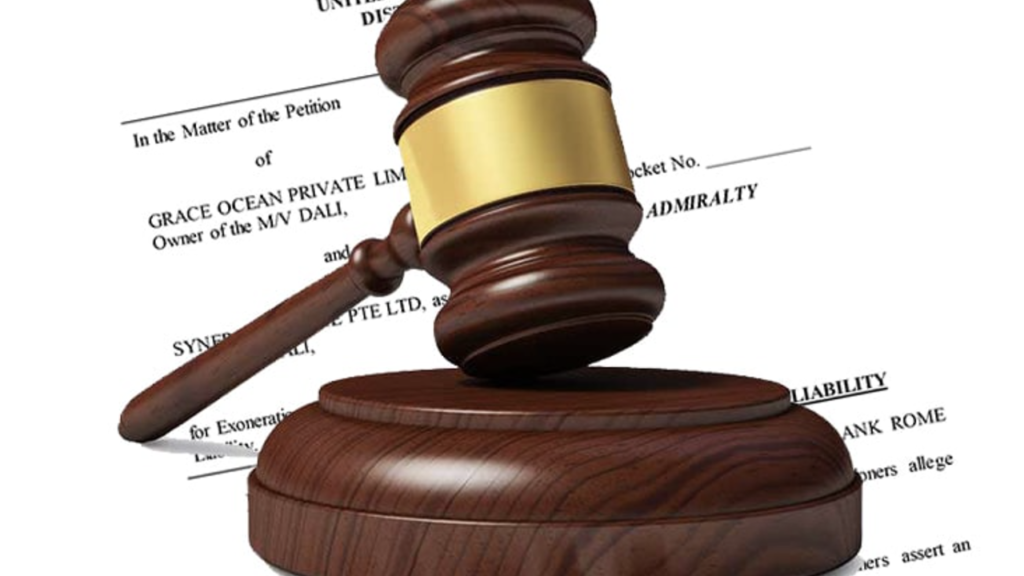
Watch: Two Baltimore Temporary Channels Now Open (UPDATED)
Written by Nick Blenkey, Senior Editorial Consultant and Web Editor, Marine Log
(Screengrab from USCG video)
As the first vessel successfully transited the Baltimore temporary channel established following the collapse of Baltimore’s Francis Scott Key Bridge, the Unified Command responding to the disaster announced the opening of a second alternate channel.
The first vessel transiting the temporary channel, at 3.00 p.m. April 1 was the tugboat Crystal Coast pushing a fuel barge used to supply jet fuel to the Department of Defense, It was transiting to Dover Air Force Base.
The first Baltimore temporary channel is on the northeast side of the main ship channel in the vicinity of the Francis Scott Key Bridge. It has a controlling depth of 11 feet, a 264-foot horizontal clearance, and vertical clearance of 95 feet. In the next part of a phased approach to opening the main federal channel, the Unified Command is working to establish a second Baltimore temporary channel on the southwest side of the main channel. This second channel will allow for deeper draft vessels with an anticipated draft restriction of 15 to 16 feet.
Two crane barges, a 650-ton crane and a 330-ton crane, are actively working on scene. Wreckage will continue to be lifted and transferred to a barge as daylight allows. A 230-ton land-based crane will offload and process the wreckage at Tradepoint Atlantic in Sparrows Point, Md. It will then be taken to a disposal site.
The current 2,000-yard safety zone around the Francis Scott Key Bridge remains in effect and is intended to protect personnel, vessels, and the marine environment. Members of the public may not enter the safety zone unless authorized by the COTP or designated representative. Those in the safety zone must comply with all lawful orders or directions given to them by the COTP or designated representative.
Second Temporary Channel
COTP has also established a second temporary alternate channel on the southwest side of the main channel near Hawkins Point in the vicinity of the Francis Scott Key Bridge for commercially essential vessels.
This action is part of a phased approach to opening the main channel. The second temporary channel is marked with government lighted aids to navigation and will be limited to transit at the discretion of the COTP and during daylight hours only. It has a controlling depth of 14 feet, a 280-foot horizontal clearance, and a vertical clearance of 124 feet.
Established for commercially essential vessels, the channels are suitable for vessels like tugboats and low-draft barges for day use only and with the clearance of the COTP, the two temporary-alternate channels represent a step forward to resuming limited shipping capacity within the Port of Baltimore.

“The opening of these two alternate channels and transit of critical response resources, as well as the first commercial traffic movements through the area, is a significant milestone in our response efforts,” said U.S. Coast Guard Cmdr. Baxter Smoak, operations section chief of the Key Bridge Response 2024. “Our number one priority remains the opening of the deep draft channel. We are simultaneously focused on opening additional routes of increased capacity as we move forward.”
Challenges
While the opening of the two alternate channels is a hopeful sign, it is becoming increasingly clear that full reopening of the Port of Baltimore may be yet a while away. The USACE has released imagery, supplied by the U.S. Navy’s Naval Sea System Command (NAVSEA) Supervisor of Salvage and Diving (SUPSALV), that shows the wreckage resting at the bottom of the river where the Francis Scott Key Bridge once stood.

These 3D images show the sheer magnitude of the very difficult and challenging salvage operation ahead. The underwater sonar imaging tool, known as CODA Octopus, is the primary survey tool used by divers, with visibility clouded to just one to two feet because of the four to five feet of mud and loose bottom of the Patapsco River.
Divers are forced to work in virtual darkness, because when lit, their view is similar to driving through a heavy snowfall at night with high-beam headlights on. So murky is the water, notes the Corps, that divers must be guided via detailed verbal directions from operators in vessels topside who are viewing real-time CODA imagery. No usable underwater video exists of the wreckage, because as one Navy diver stated, “there’s no need take video of something you can’t even see.”
The Key Bridge Response 2024 Unified Command includes the:
- U.S. Coast Guard
- U.S. Army Corps of Engineers
- Maryland Department of the Environment
- Maryland Transportation Authority
- Maryland State Police
- Witt O’Brien’s, representing Synergy Marine, the operator of the 10,000 dwt containership Dali that struck the bridge March 26 and that remains trapped beneath a section of the roadway that ran across the bridge.

Meanwhile, the owner and manager of the Dali has filed a petition in U.S. District Court April 1 seeking exoneration from or limitation of liability in relation to the incident. (This will come as little surprise to Marine Log readers, though it may come as a shocker to many in Baltimore.)
Similar petitions under the Shipowners Limitation of Liability Act of 1851, which limits claims to the value of a vessel plus any outstanding freight revenues, were filed in the case of the loss of the El Faro in 2015 and the Conception dive boat fire in 2019.
In the current petition, the owner of the Dali, Grace Ocean Private Limited, and the manager, Synergy Marine Pvte. Ltd, both Singapore-based, assert an admiralty and maritime claim within the meaning of Rule 9(h) of the Federal Rules of Civil Procedure.
Among interesting details in the filing is that the cost of repairs to the Dali are estimated to be at least $28 million and salvage costs at least $19.5 million.
The petition states, in part:
“The Casualty was not due to any fault, neglect, or want of care on the part of Petitioners, the Vessel, or any persons or entities for whose acts Petitioners may be responsible.
“Alternatively, if any such faults caused or contributed to the Casualty, or to any loss or damage arising out of the Casualty, which is denied, such faults were occasioned and occurred without Petitioners’ privity or knowledge.”
“The sound value of the Vessel at the time of the voyage did not exceed $90,000,000.
“Substantial investigation of the damage to the Vessel as a result of the Casualty is ongoing; however, repair costs are presently estimated to be at least $28,000,000.
“Salvage of the Vessel is ongoing; however, salvage costs are presently estimated to be at least $19,500,000.
“Accordingly, the value of the Vessel at the termination of the voyage is presently estimated to be approximately $42,500,000.
“There was pending freight in connection with the voyage of approximately $1,170,000.
“Subject to an express reservation of rights, Petitioners offer an Interim Stipulation of Value in the amount of $43,670,000 (i.e., sound value of the vessel plus pending freight less repair costs and salvage costs). Petitioners’ Interim Stipulation is being filed herewith. The value in the Interim Stipulation is expected to be substantially less than the amount that has been or will be claimed for any losses or damages arising out of the Casualty. Petitioners will file an amended stipulation for value once the repair and salvage costs are finally determined.
“Accordingly, the value of the Vessel at the termination of the voyage is presently estimated to be approximately $42,500,000.
“There was pending freight in connection with the voyage of approximately $1,170,000.
“Subject to an express reservation of rights, Petitioners offer an Interim Stipulation of Value in the amount of $43,670,000 (i.e., sound value of the vessel plus pending freight less repair costs and salvage costs).”
Read the full petition below to learn what the Dali owner and manager are asking and its implications for potential claimants:

![Balsa 91 transits the Fort McHenry Channel [Key Bridge Response 2024 Unified Command photo by U.S. Army Corps of Engineers Visual Information Specialist Christopher Rosario]](https://www.railwayage.com/wp-content/uploads/2024/04/Balsa91-315x168.jpg)

